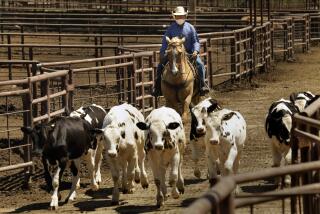It Was a Lean Year for the Butcher
- Share via
Although turkey sales were strong last season, in general 1984 was not a good year for the butcher. Indeed, the meat industry has been contending with a sufficient flow of bad news during the last few years to flood the average pasture out of production.
Meat is under a health cloud: There’s the cholesterol and heart attack problem, the fat and cancer problem; and for the blood pressure and stroke problem, there’s all that salt in processed meats. Most of us would benefit from cutting back on the flesh in our diet, a traditional hallmark of abundance and wholesome eating. The health admonition to eat more fruits and vegetables, more beans and grains may be good news for the grocer but they’ve left the butcher cold.
And cold it was exactly a year ago for the dwindling band of diet-heart skeptics when government scientists announced results of their definitive $150-million, 10-year study that lowering blood cholesterol levels does protect against heart disease. Central to any strategy for lowering the blood cholesterol is reducing the intake of saturated fat and cholesterol. That’s meat, milk, eggs, ice cream and cheese.
Cancer Folks Heard From Then we heard from the cancer folks. Last February the American Cancer Society issued food recommendations for the first time in its history. They advised us to cut dietary fat intakes and increase food fiber. Several weeks later the National Cancer Institute weighed in with similar advice. And finally, in the spring a dispirited face of bacon and eggs stared out from newsstands everywhere, on the cover of Time magazine.
In the past, as such information accumulated, defenders of today’s food habits, the “best diet in the world,” rounded up a few stray nutrition scientists for a publicity counterblast as highly charged as the bad news seemed to require. But last year there was a different response. Instead of treating the accumulating science as so many floating mines threatening the Good Ship Nutrition, major food trade groups began issuing statements agreeing with the principle of avoiding too much fat. They began to remind us, for example, that meat is leaner than it’s been for years, and that is true. Dressed meat fat content fell 3% between 1960 and 1984. Leaner cattle and pigs are being raised because of a shrinking market for lard and suet. The edible oil industry, with its pressings from corn, palm and coconut, continues to encroach on the markets of traditional fat producers. So the fats and oils in our diet remain at all-time highs.
In the natural state, diets as high in fats as ours are rare. Until very recently most human cultures obtained only 10% or 20% of their day’s calories from fats and oils, but by the turn of the century the American diet provided 30% of its calories from fat. Today it provides 42%, and they come from three major sources--animal fat, dairy fat and edible oils.
More to Read
Eat your way across L.A.
Get our weekly Tasting Notes newsletter for reviews, news and more.
You may occasionally receive promotional content from the Los Angeles Times.









